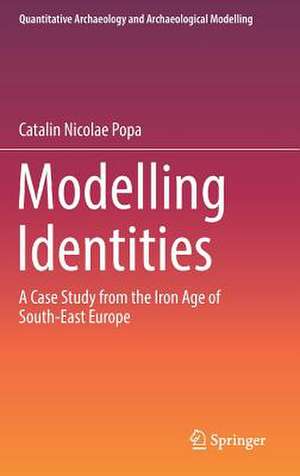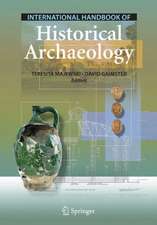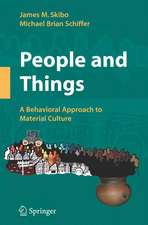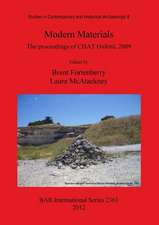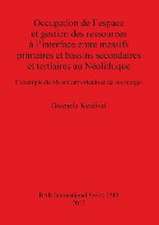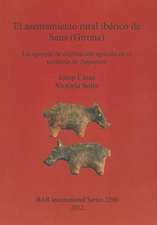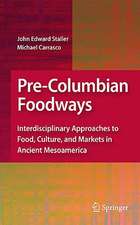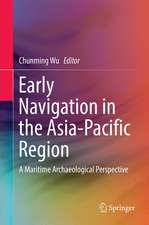Modelling Identities: A Case Study from the Iron Age of South-East Europe: Quantitative Archaeology and Archaeological Modelling
Autor Catalin Nicolae Popaen Limba Engleză Hardback – 5 iun 2018
The volume also aims to show the compatibility of archaeological theory and statistical modelling. The discussions from archaeological theory rarely find methodological implementations through statistical methods. In this volume, theoretical issues form an integrative part of data preparation, method development and result interpretation.
| Toate formatele și edițiile | Preț | Express |
|---|---|---|
| Paperback (1) | 527.15 lei 6-8 săpt. | |
| Springer International Publishing – 22 dec 2018 | 527.15 lei 6-8 săpt. | |
| Hardback (1) | 533.39 lei 6-8 săpt. | |
| Springer International Publishing – 5 iun 2018 | 533.39 lei 6-8 săpt. |
Preț: 533.39 lei
Preț vechi: 627.51 lei
-15% Nou
Puncte Express: 800
Preț estimativ în valută:
102.10€ • 110.94$ • 85.82£
102.10€ • 110.94$ • 85.82£
Carte tipărită la comandă
Livrare economică 22 aprilie-06 mai
Preluare comenzi: 021 569.72.76
Specificații
ISBN-13: 9783319632650
ISBN-10: 3319632655
Pagini: 272
Ilustrații: XIII, 272 p. 68 illus., 29 illus. in color.
Dimensiuni: 155 x 235 x 24 mm
Greutate: 0.58 kg
Ediția:1st ed. 2018
Editura: Springer International Publishing
Colecția Springer
Seria Quantitative Archaeology and Archaeological Modelling
Locul publicării:Cham, Switzerland
ISBN-10: 3319632655
Pagini: 272
Ilustrații: XIII, 272 p. 68 illus., 29 illus. in color.
Dimensiuni: 155 x 235 x 24 mm
Greutate: 0.58 kg
Ediția:1st ed. 2018
Editura: Springer International Publishing
Colecția Springer
Seria Quantitative Archaeology and Archaeological Modelling
Locul publicării:Cham, Switzerland
Cuprins
Chapter 1. Introduction.- Chapter 2. Final resting place. The archaeological data.- Chapter 3. The working apparatus. Identity and statistics.- Chapter 4. A complex answer. Results description.- Chapter 5. From large to small. Results discussion.- Chapter 6. The overall picture. Concluding interpretations.
Notă biografică
Cătălin Popa is a Postdoctoral Researcher at the University of Leiden. He received his B.A. from the Babeș-Bolyai Unviersity and his M.Phil. and Ph.D. (2014) from the University of Cambridge. From 2014 until 2016 he was a Dahlem Research School Postdoctoral Fellow in the Excellence Cluster Topoi, Freie Universität Berlin. Much of his research has been concentrated on the integration of archaeological theory with statistical methods, particularly when applied to issues of identity and landscape. He also has a broad interests in European Prehistory, particularly the Iron Age period. He is additionally working on the relationship between archaeology and nationalism, exploring the instrumentalisation and mythologisation of the past for national purposes or various political aims.
Textul de pe ultima copertă
This volume investigates the construction of group identity in Late La Tène South-East Europe using an innovative statistical modelling method. Death and burial theory underlies the potential of mortuary practices for identity research. The sample used for this volumes's research consists of 370 graves, organized in a specially crated database that records funerary ritual; and grave-good information. In the case of grave-goods, this involved found hierarchically organized categorical variables, which serve to describe each item by combining functional and typological features.
The volume also aims to show the compatibility of archaeological theory and statistical modelling. The discussions from archaeological theory rarely find methodological implementations through statistical methods. In this volume, theoretical issues form an integrative part of data preparation, method development and result interpretation.
The volume also aims to show the compatibility of archaeological theory and statistical modelling. The discussions from archaeological theory rarely find methodological implementations through statistical methods. In this volume, theoretical issues form an integrative part of data preparation, method development and result interpretation.
Caracteristici
Combines archaeological theory and statistical analysis Contains full archaeological interpretation narrative Data preparation, method description and implementation, results evaluation, description and interpretation are all included
